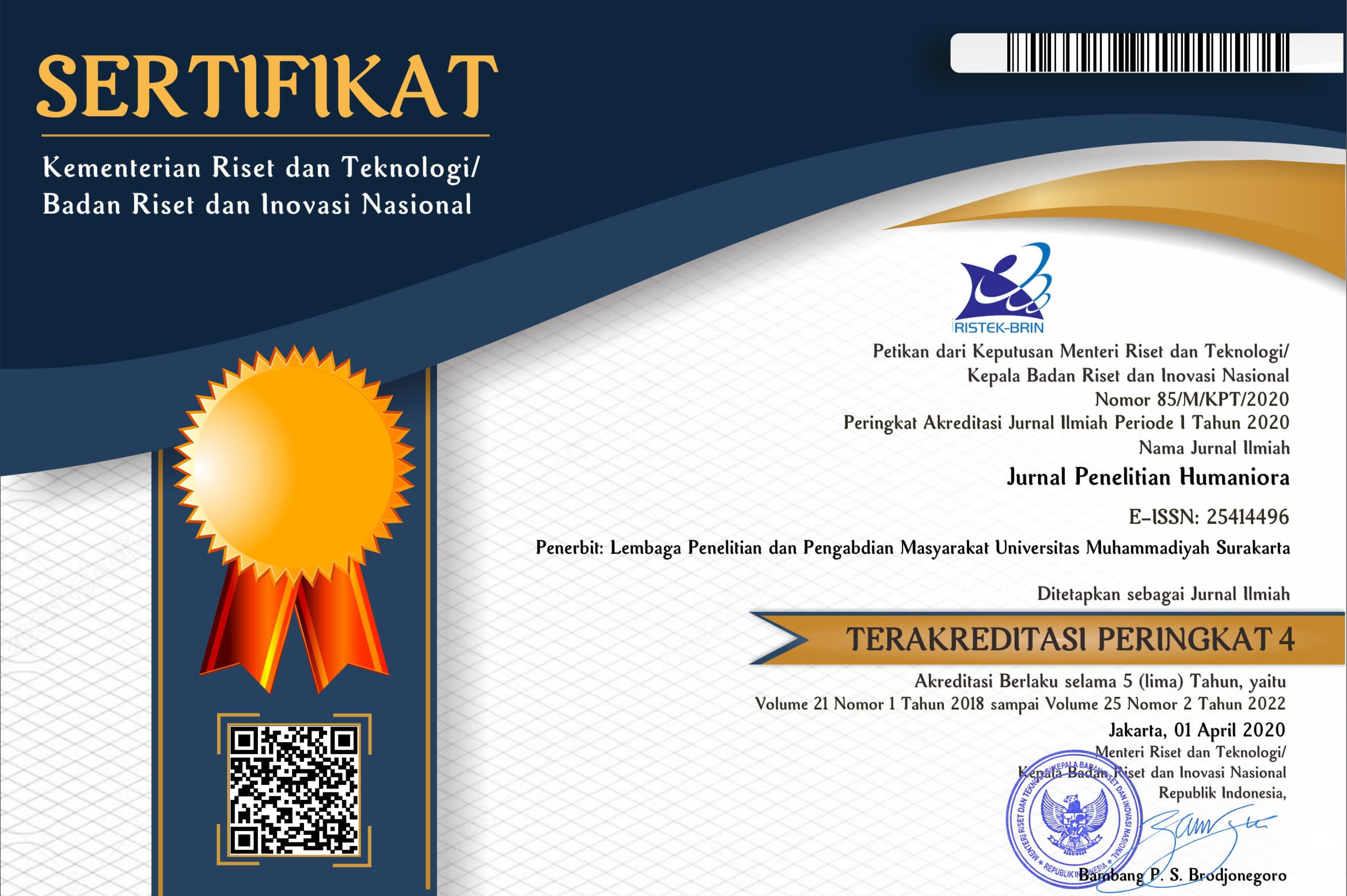ENGAGING PRE SERVICE TEACHERS IN MULTIMODAL READING WITH LEARNING LOGS: AN ACTION CLASSROOM-BASED RESEARCH
Elih Sutisna Yanto(1*), Kusrin Kusrin(2)(1) Universitas Singaperbangsa Karawang
(2) Universitas Singaperbangsa Karawang
(*) Corresponding Author
Abstract
Students’ reading comprehension on disciplinary texts commonly involves the interaction between the cognitive aspect and the text itself, but little is known how it is carried out through multimodal reading. To fill this practical void, this article reports the findings of classroom action research of the pre-service teachers learning disciplinary vocabularies through different modes of meaning, the socially and culturally shaped resources or semiotic structure for making meaning: video viewing and graphic organizers. This study proposes that multimodal reading has the potential to promote the role of student teachers as designers and navigators in reading English disciplinary texts. Pedagogically, this multimodal engagement not only creates interactive content learning but also it encourages the students to become autonomous language learners. In addition to multimodal reading activities, the students were motivated not only to learn about language but also to learn through language. Moreover, multimodality reading tasks can scaffold comprehension and production of the academic language of the students. Finally, students who are engaged in cognitive work in content areas (e.g., statistics for second language research) have the motivation to learn a language that supports their learning. Multimodality reading tasks can support students ‘communication, increasing students’ academic writing and students’ academic vocabulary development as well.
Keywords
Full Text:
PDFReferences
An, S. (2013). Schema Theory in Reading. Theory and Practice in Language Studies, 3(1), 130-134.
Aktulum, K. (2017). What Is Intersemiotics? A Short Definition and Some examples. International Journal of Social Science and Humanity, 7(1), 33.
Bowden, J. A., & Green, P. (Eds.). (2005). Doing developmental phenomenography. Victoria: RMIT University Press.
Coburn, Daniel. (2003). Using graphic organizers. Science Scope, 27(1), 46-48.
Costley, J., Hughes, C., & Lange, C. (2016). The effects of instructional design on student engagement with video lectures at cyber universities. Journal of Information Technology Education: Research, 16(1), 189–207.
Creswell, J. (2012). Educational research. Boston, MA: Pearson Education.
Dye, G. A. (2000). Graphic organizers to the rescue! Helping students link and remember information. Teaching Exceptional Children, 32(3), 72-76.
Fadel, C., & Lemke, C. (2012). Multimodal learning through media. In N. M. Seel (Ed.), Encyclopedia of the sciences of learning (pp. 2378–2381). New York: Springer.
Gill, Sharon. (2008). The comprehension matrix: A tool for designing comprehension instruction. The Reading Teacher, 62(2), 106-113.
Kemmis, S., McTaggart, R., & Nixon, R. (2014). The action research planner: Doing critical participatory action research. Singapore: Springer.
Kharb, P., Samanta, P. P., Jindal, M., & Singh, V. (2013). The learning styles and the preferred teaching-learning strategies of first-year medical students. Journal of clinical and diagnostic research: JCDR, 7(6), 1089–1092.
Kress, G. R., & Jewitt, C. (2003). Introduction. In C. Jewitt & G. R. Kress (Eds.), Multimodal literacy (pp. 1–18). New York, NY: Peter Lang.
Richards, K. (2003). Qualitative inquiry in TESOL. New York: Palgrave Macmillan.
Paxton, M., Frith, V., Kelly-Laubscher, R., Muna, N., & van der Merwe, M. (2017). Supporting the teaching of the visual literacies in the earth and life sciences in higher education. Higher Education Research & Development, 36(6), 1264–1279.
Roberts, D. (2017). The engagement agenda, multimedia learning and the use of images in higher education lecturing: Or, how to end death by PowerPoint. Journal of Further and
Higher Education. https ://doi.org/10.1080/03098 77X.2017.13323 56.
Sankey, M., Birch, D., & Gardiner, M. (2010). Engaging students through multimodal learning environments: The journey continues. In Proceedings ASCILITE 2010: 27th annual conference of the Aus Australasian Society for Computers in Learning in Tertiary Education: Curriculum, technology and transformation for an unknown future (pp. 852–863). Brisbane: University of Queensland.
Tungka, N. F. (2018). Guided literacy instruction: Helping students read multimodal English medium texts. Indonesian Journal of Applied Linguistics, 8, 345-357. DOI: 10.17509/ijal.v8i2.13281
Walker, J. D., Cotner, S., & Beermann, N. (2011). Vodcasts and captures: Using multimedia to improve student learning in introductory biology. Journal of Educational Multimedia and Hypermedia, 20(1), 97–111.
Widodo, H. P. 2015. The Development of Vocational English Materials from a Social Semiotic Perspective: Participatory Action Research. Doctoral Thesis. University of Adelaide, Australia.
Yanto, E. S., & Pahlevi, M. R. (2018). Developing Student Teachers’ Academic Language in Collaborative and Reflective Multimodality" Assisted Content Learning in an Indonesian Initial Teacher Education (ITE) Context. In International Conference on Language Phenomena in Multimodal Communication (KLUA 2018). Atlantis Press.
Yanto, E. S. & Nugraha, S.I. (2018).Video Viewing as a Vehicle For Learning Content-based Vocabulary: Helping Students Understand Disciplinary Vocabulary in Context. In Widodo, H. P. (Ed.) Researching English Language Pedagogy and Teacher Professional Development in Indonesia’s Educational Landscape.
Vygotsky, L.S. (1962). Thought and Language.Cambridge. MA: MIT Press.
Article Metrics
Abstract view(s): 1391 time(s)PDF: 947 time(s)
Refbacks
- There are currently no refbacks.











